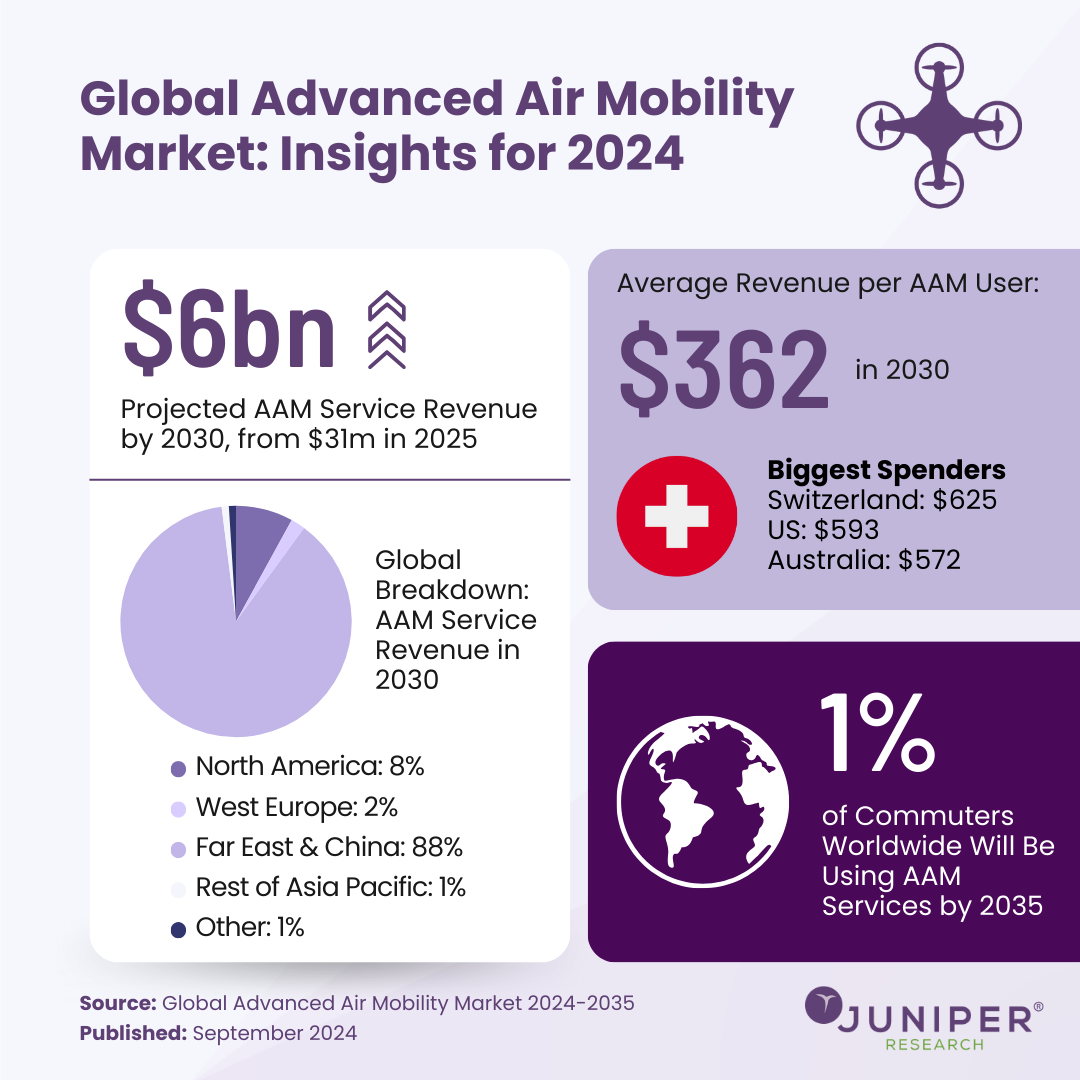Global Advanced Air Mobility Market: Insights for 2024


From The Jetsons to Star Wars and Blade Runner, flying taxis have been captivating travellers since the earliest days of science fiction; promising a future of seamless, skyborne commutes over traffic-choked streets and bustling public transit. However, this once-fanciful concept is inching closer to reality; driven by groundbreaking advancements in electric propulsion, autonomous systems, and aerospace design.
Advanced Air Mobility, or AAM, stands to revolutionise how we transport people and cargo and in doing so, offers unprecedented solutions to everyday problems such as congestion and last-mile connectivity, to larger issues such as environmental sustainability and urbanisation.
As we discuss in our latest research, it is important to differentiate between two distinct segments with AAM:
UAM (Urban Air Mobility)
UAM refers to the use of these aircraft in urban environments. By providing a fast, convenient alternative to the most common types of single rider transportation found in towns and cities – including taxis and private ICE-powered (Internal Combustion Engine) vehicles – it aims to alleviate urban congestion, lessen travel times, and, crucially, reduce the amount of carbon emissions generated by people travelling within, and between, these areas.
UAM is arguably the most important segment to the growth of AAM. By their very nature, major towns and cities are crowded with consumers, commuters, and travellers. As long as services are marketed and priced correctly, AAM service operators can therefore start building a user base with relative ease – and in turn, begin demonstrating the financial viability of UAM, if not funding future expansion into other AAM segments.
RAM (Regional Air Mobility)
By contrast, RAM refers to the use of these aircrafts to provide efficient aerial transportation over longer distances, for instance, between cities or across larger regional areas; providing sustainable transportation options for both passengers and cargo in less densely populated areas.
Achieving success in this market will require service operators to be bold to overcome the myriad of hurdles that this market presents, including finding an all important balance between inclusivity and financial viability. But just as the risks are high, so are the rewards – which include not just leading at the cutting-edge of mobility services, but making a difference to residents’ quality of life and economic prospects.
Source: Global Advanced Air Mobility Market 2024-2035
Download the Whitepaper: The Sky’s the Limit: The Opportunities of the Advanced Air Mobility Market
Latest research, whitepapers & press releases
-
 ReportDecember 2025
ReportDecember 2025AI Agents for Customer Experience Platforms Market: 2025-2030
Our comprehensive AI Agents for Customer Experience Platforms research suite comprises detailed assessment of a market that is set to disrupt mobile communications. It provides stakeholders with insight into the key opportunities within the AI agents for customer experience platforms market over the next two years.
VIEW -
 ReportDecember 2025Fintech & Payments
ReportDecember 2025Fintech & PaymentseCommerce Fraud Prevention Market: 2025-2030
Our eCommerce Fraud Prevention research suite provides a detailed and insightful analysis of this evolving market; enabling stakeholders from financial institutions, law enforcement agencies, regulatory bodies and technology vendors to understand future growth, key trends, and the competitive environment.
VIEW -
 ReportNovember 2025Telecoms & Connectivity
ReportNovember 2025Telecoms & ConnectivityeSIMs & iSIMs Market: 2025-2030
Juniper Research’s eSIMs and iSIMs research suite offers insightful analysis of a market set to experience significant growth in the next five years. The research suite provides mobile network operators (MNOs), original equipment manufacturers (OEMs), and eSIM management and platforms vendors with intelligence on how to capitalise on the market growth, and guidance on how eSIM-only devices and sensors, SGP.42, in-factory provisioning, and iSIMs will change the competitive landscape.
VIEW -
 ReportNovember 2025Fintech & Payments
ReportNovember 2025Fintech & PaymentsModern Card Issuing Platforms Market: 2025-2030
Our Modern Card Issuing Platforms Market research suite provides a detailed and insightful analysis of this evolving market; enabling stakeholders from banks, financial institutions, fintech companies, and technology vendors to understand future growth, key trends, and the competitive environment.
VIEW -
 ReportNovember 2025Fintech & Payments
ReportNovember 2025Fintech & PaymentsDigital Wallets Market: 2025-2030
Our digital wallets research suite provides detailed analysis of this rapidly changing market; allowing digital wallet providers to gain an understanding of key payment trends and challenges, potential growth opportunities, and the competitive environment.
VIEW -
 ReportOctober 2025Fintech & Payments
ReportOctober 2025Fintech & PaymentsDigital Identity Market: 2025-2030
Juniper Research’s Digital Identity research suite provides a comprehensive and insightful analysis of this market; enabling stakeholders, including digital identity platform providers, digital identity verification providers, government agencies, banks, and many others, to understand future growth, key trends, and the competitive environment.
VIEW
-
 WhitepaperDecember 2025Telecoms & Connectivity
WhitepaperDecember 2025Telecoms & ConnectivityHuman + AI: Drivers of Customer Experience AI Agents in 2026
Our complimentary whitepaper, Human + AI: Drivers of Customer Experience AI Agents in 2026, examines the key drivers of the AI agents for customer experience platforms market in 2025.
VIEW -
 WhitepaperDecember 2025Fintech & Payments
WhitepaperDecember 2025Fintech & PaymentsBeyond Chargebacks: The True Cost of Fraud for Digital Commerce
Our complimentary whitepaper, Beyond Chargebacks: The True Cost of Fraud for Digital Commerce, examines the state of the eCommerce fraud prevention market; considering the impact of evolving digital fraud strategies, including key trends such as identity theft, account takeovers, chargebacks, policy abuse and friendly fraud.
VIEW -
 WhitepaperNovember 2025Telecoms & Connectivity
WhitepaperNovember 2025Telecoms & ConnectivityeSIM-only Devices: The Impact on Operators, Consumers, and IoT
Our complimentary whitepaper, eSIM-only Devices: The Impact on Operators, Consumers, and IoT, explores the challenges and opportunities for the three segments, with a particular focus on eSIM-only smartphones and SGP.42.
VIEW -
 WhitepaperNovember 2025Fintech & Payments
WhitepaperNovember 2025Fintech & PaymentsUnlocking the Next Stage of Growth for Modern Card Issuing Platforms
This free whitepaper analyses key trends shaping the modern card issuing space, and the ways in which modern card issuing platforms can capture growth.
VIEW -
 WhitepaperNovember 2025Fintech & Payments
WhitepaperNovember 2025Fintech & PaymentsTop 10 Fintech & Payments Trends 2026
Fintech is evolving fast. From stablecoins to agentic AI, our annual guide reveals the shifts redefining payments, digital identity, and the future of money in 2026. Download your copy today.
VIEW -
 WhitepaperNovember 2025Fintech & Payments
WhitepaperNovember 2025Fintech & PaymentsDigital Wallets: Empowering Financial Inclusivity
Our complimentary whitepaper, Digital Wallets: Empowering Financial Inclusivity, examines the state of the digital wallets market; considering the impact of digital wallets on different geographies, how they are shaping the modern payments landscape through lower transaction fees and promoting financial inclusivity for underbanked populations, and how they are competing with established payment methods.
VIEW
-
IoT & Emerging Technology
Juniper Research Unveils Top 10 Emerging Tech Trends to Watch in 2026
January 2026 -
Fintech & Payments
Digital Identity App Usage to Hit 6.2 Billion by 2030, Driven by Shift to Decentralised Models
December 2025 -
Telecoms & Connectivity
Travel eSIM Margins Under Pressure as Revenue per Gigabyte Falls 10% Globally in Two Years
December 2025 -
Telecoms & Connectivity
AI Agents to Power 1,000% More Customer Interactions for Enterprises Globally by 2027
December 2025 -
IoT & Emerging Technology
Global D2C Revenue Set for $370 Million Surge, But Satellite Operators Should Not Chase Full MNO Status
December 2025 -
Fintech & Payments
Digital Goods Fraud to Cost eCommerce Merchants $27 Billion Globally by 2030 as AI Tools Accelerate Attacks
December 2025


















